Pipelink is a spatial awareness puzzle from Japan. There are no numbers, there’s no complex mathematics, and no fancy formulas. The objective is very simple: to link all the cells in the grid with a single, continuous pipeline.
In a hurry? Jump to: Rules / Tips / Worked Example / Video Tutorial / Download Free Puzzles / Books
Here’s what a very easy Pipelink puzzle looks like:
The rules are straightforward:
Here’s what our earlier example puzzle looks like once solved:
These puzzles are solved through logical deduction and spatial reasoning. We begin with what we know — the given pipe segments – and using that knowledge we work out where we can and cannot extend them. As we grow the pipeline a segment at a time, we slowly reduce the options for where subsequent segments can be placed.
Here are some tips to help you get started.
We will work through a sample puzzle from beginning to end. As with most puzzles, remember that there’s no single way to solve it. The larger the puzzle, the more possible paths to reach the final solution.
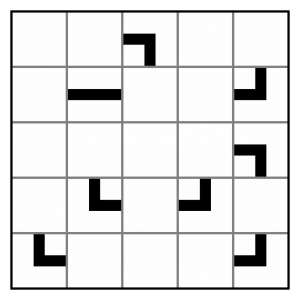
This is the puzzle we will be working on. It’s an easy grid, but sufficient to demonstrate the techniques used to solve Pipelink puzzles.
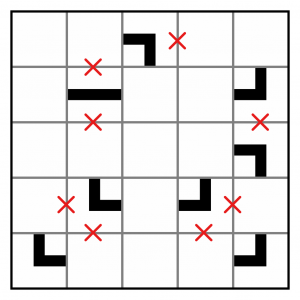
We can begin by marking out routes we know the pipe cannot take. This will be helpful later when we come to start extending it. Because we cannot add to the given segments, we know our pipe can’t go anywhere we’ve marked with a red cross.
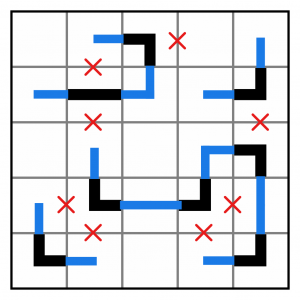
Next we can extend all the given segments into the middle of the adjoining cells. Doing so has connected some sections of the pipeline together – we’re making progress already!
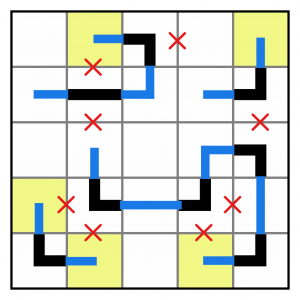
We can continue extending the pipe. The segments in the highlighted cells can only be extended in a single direction…

…so we can extend those.
Where next? Let’s examine the grid further…
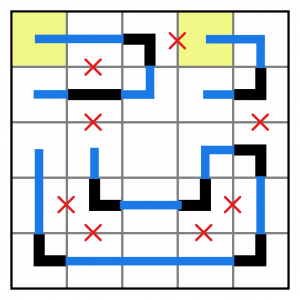
The two highlighted cells have only one possible direction to extend. We have to extend them both downwards.
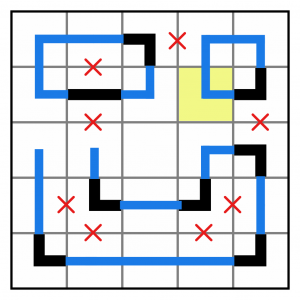
But this leaves us with a problem. We’ve got two ‘islands’ that are isolated from the rest of the pipeline below. We’ll deal with the smaller one first. If we are to connect it to the rest of the pipeline, we can only do so from the highlighted cell. There’s simply no other option. Do we go down, or to the left? The answer, of course, is both! We cannot have a cell with three segments entering/exiting, it’s either two or four (because either the pipeline traverses the cell, or it crosses itself within the cell). So we can draw those extensions in now.
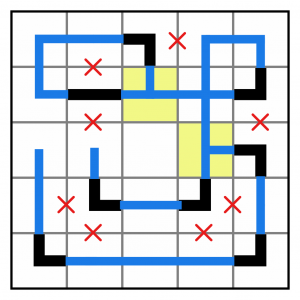
That’s connected the top right-hand island, but it’s given us a two new problems – the highlighted cells are invalid because they have three entries/exits. Of course, these aren’t really problems, they’re opportunities, because we know we have to add a fourth segment to both of them. They must be crossings.
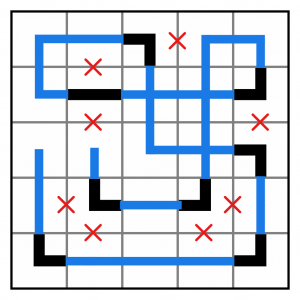
We’re almost done. We just have one gap, and it’s an easy one to connect up…
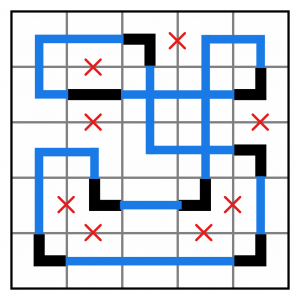
…which completes the puzzle. It’s fairly easy to see that this solution is valid just by looking. With larger puzzles, it can be harder to be sure your solution is valid. To check a solution, it can be worth tracing the entire pipeline with a different colour to make sure you can cover off the whole thing, and every cell, without lifting the pencil or stylus.
Ready to have a go yourself? We’ve put together a taster of four puzzles for you, including the example above. You can download and print the PDF below. Solutions are included, but no cheating!
Want to get properly stuck into some Pipelink puzzles? We have just the book for you! Puzzle Weekly Presents: Pipelink is a collection of 120 brand new challenges spread over seven levels of difficulty. With one puzzle per page, there's plenty of space for experimentation and notes. And of course, all the solutions are included as well, to make checking your own a breeze. Find out more here.
We publish Pipelink puzzles in Puzzle Weekly from time to time. Puzzle Weekly is our free weekly puzzle magazine – find out more, and get your copy, here